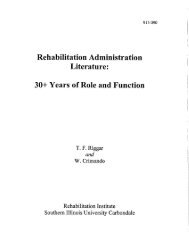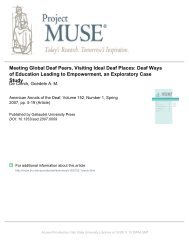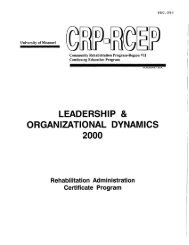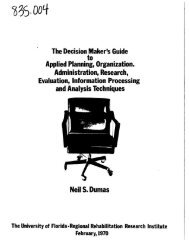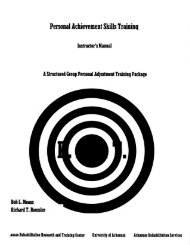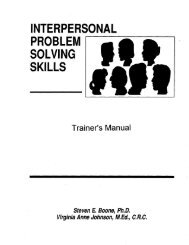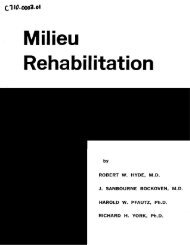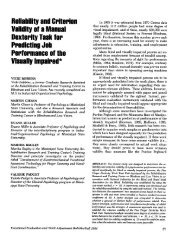by requirements for the degree of (Education) - NCRTM
by requirements for the degree of (Education) - NCRTM
by requirements for the degree of (Education) - NCRTM
You also want an ePaper? Increase the reach of your titles
YUMPU automatically turns print PDFs into web optimized ePapers that Google loves.
time had .elapsed, however, <strong>for</strong> this to be a significant measure <strong>of</strong> <strong>the</strong><br />
success <strong>of</strong> VR involvement in terms <strong>of</strong> <strong>the</strong> long-term effectiveness <strong>of</strong><br />
services provided.<br />
Only eight people in <strong>the</strong> three years studied received an extended<br />
evaluation. Does this mean that <strong>the</strong> most severely handicapped were not<br />
given <strong>the</strong> benefit <strong>of</strong> an extended evaluation and were screened out, or are<br />
<strong>the</strong>re really only a few EMR's who need such an evaluation and that it is<br />
used primarily <strong>for</strong> <strong>the</strong> trainable mentally retarded?<br />
A study <strong>of</strong> rehabilitated closures shows that 73% were identified as<br />
mildly retarded, 24% as moderately retarded and three per cent as severely<br />
retarded, as defined <strong>by</strong> <strong>the</strong> DVR Case Process Guide (see Chapter IV, p.age<br />
68, <strong>of</strong> this paper). It would be interesting to compare <strong>the</strong>se figures witk<br />
a breakdown <strong>of</strong> <strong>the</strong> total population <strong>of</strong> EMRts reported to determine if <strong>the</strong><br />
percentages served within each. level <strong>of</strong> retardation differ s.ignificantly<br />
from <strong>the</strong> percentages reported.<br />
The average case service costs varied considerably among districts.<br />
These differences raise questions regarding <strong>the</strong> types <strong>of</strong> services provided<br />
as well as <strong>the</strong>ir costs within <strong>the</strong> respective districts. Do some districts<br />
use rehabilitation facilities (sheltered workshops) more extensively than<br />
o<strong>the</strong>rs, i.e., <strong>for</strong> la.rger numbers <strong>of</strong> clients and/or <strong>for</strong> longer periods <strong>of</strong><br />
time? What are <strong>the</strong> district policies regarding reimbursement <strong>for</strong> on-<strong>the</strong>-<br />
training i.e., rate <strong>of</strong> reimbursement and length <strong>of</strong> subsidized training?<br />
job<br />
study reported that 81% <strong>of</strong> <strong>the</strong> rehabilitated closures were closed<br />
This<br />
as competitively .employed; however, only in<strong>for</strong>mation on work status and<br />
was reported. It would be interesting to study <strong>the</strong>se closures<br />
earnings<br />
todetermine <strong>the</strong> type <strong>of</strong>job and <strong>the</strong> tasks per<strong>for</strong>med; what<br />
more'comprehensively<br />
intellectual, personal, social andvocational skills and training are<br />
9O




